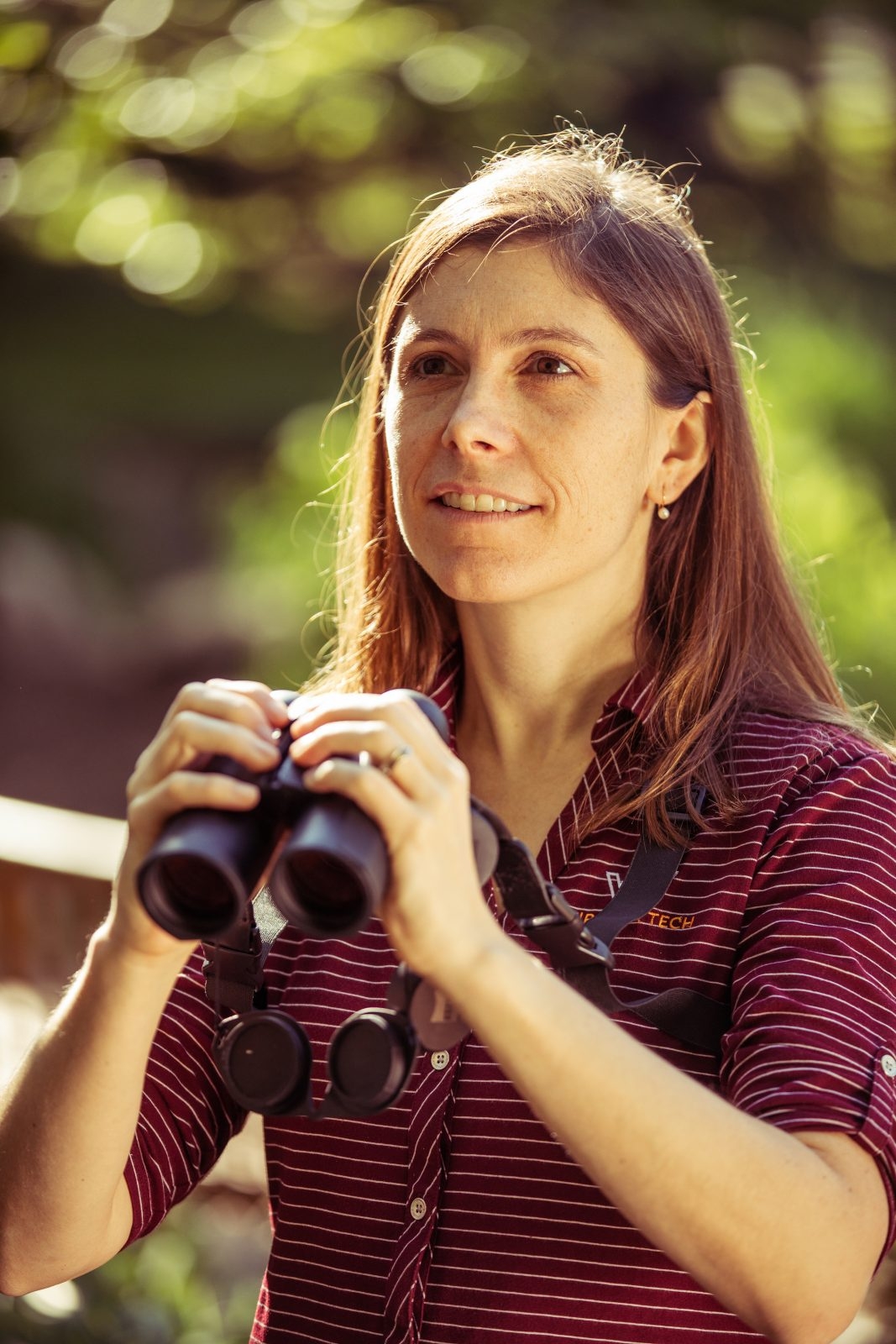Ashley Dayer

Bringing the Human Dimension to Bird Conservation
People often assume that Ashley Dayer is an ornithologist when first learning of her research program’s emphasis on bird conservation, bird watching, and bird feeding. Dayer, an assistant professor in the department of Fish and Wildlife Conservation in the College of Natural Resources and Environment, and director of the Dayer Human Dimensions Lab, however, considers herself to be primarily a social scientist. She believes that understanding the human dimensions of wildlife conservation is a key element to addressing conservation challenges, and that using social science methods and perspectives are necessary tools to advance this understanding.

According to Dayer, the social sciences, which include disciplines such as social psychology, political science, sociology, geography, policy and communications, can contribute important theoretical concepts and methodological strategies to better understand how humans impact the natural world and in turn, how nature effects people.
Dayer often uses mixed methods to conduct her research, including surveys, conducted online, in person and over the phone, along with focus groups, facilitated workshops, observational studies and website reviews. These types of methods are important tools to ferreting out human attitudes and beliefs about wildlife as well as their motivations in supporting or hindering conservation efforts.
“I am also interested in the impact of bird feeding on human wellbeing. For example, do people find bird song soothing or interactions with the pesky squirrel a source of stress?” Dayer said. She noted that bird feeding may be one of the few ways many people interact with wildlife in today’s modernized society. Better understanding of human interactions with wildlife can lead to improved conservation strategies as well as understanding how wildlife can impact wellbeing and a sense of connection to nature.
Dayer’s recent study of people who feed birds, which she conducted with Dana Hawley, associate professor of Biological Sciences in the College of Science, was jointly funded by the Global Change Center (GCC), where both are affiliates, and the Institute for Society, Culture and Environment (ISCE).
“This funding was important in providing the means to collect preliminary data on how humans respond to bird diversity, bird predation, and disease at their bird feeders,” said Dayer. This data collection led to their first journal article together, studying participants in Project FeederWatch, a program managed by the Cornell Lab of Ornithology, that includes over 10,000 participants who count birds who visit their backyard feeders.
Building on this study, Dayer and Hawley and colleagues at the Cornell Lab of Ornithology and the Odum School of Ecology at the University of Georgia recently submitted a proposal to the National Science Foundation (NSF) to a program focused on the integration of socio-environmental systems. This proposal would take their research to the next level, transforming Project FeederWatch into a socio-environmental research project.
Dayer said the GCC-ISCE funding also was instrumental in jumpstarting her collaboration with colleagues. “ISCE has also been very supportive of my work in other ways, too. Karen Roberto [ISCE director] served as my mentor in the [Virginia Tech] Proposal Development Institute, which helped me learn how to pitch my proposal, so that it resonates better with non-social scientists. ISCE also provided funding for two external reviewers to give feedback on my NSF proposal before I submitted it,” Dayer explained. She hopes this feedback will strengthen their proposal, so that it is more competitive and ultimately result in funding.
In addition to her research, Dayer is actively involved in conservation efforts. She serves on several subcommittees for the North American Bird Conservation Initiative and also supervises the National Bird Conservation Social Science Coordinator in her lab.
“I advocated for this high-profile position, gained national buy-in for it and worked with colleagues to secure funding for it. This coordinator aims to help the bird conservation community more meaningfully integrate social science,” Dayer explained. The position develops resources, provides training materials and consults with organizations on ways to integrate social science into their work.
Dayer is also a leader in “conservation social science” which integrates social science theories and methods into conservation activities and research. She served as president of the Board of Directors of the Society for Conservation Biology Social Science Working Group in 2018-19 and remains an active board member. She is also on the editorial boards for two journals, Human Dimensions of Wildlife and Society and Natural Resources. Dayer often provides expertise on human dimensions to inform policies and programs including as an invited participant on two National Park Service Science Advisory panels.
“My work, in collaboration with the graduate students in my lab, is guiding National Wildlife Refuge management, shaping the design of the Farm Bill conservation program, and informing outreach program priorities for national conservation organizations and bird conservation networks,” Dayer said.
Her role on a National Park Service science panel, focused on the threat to national parks by invasive animal species, led to the publication of a journal article in Biological Invasions, which received recent media coverage by the BBC, CNN, Newsweek and other national news outlets.
Her hope is that her work will inspire conservation biologists and policy and decision makers to more frequently integrate social science into their research; she offers formal training in social science techniques and promotes conservation social science in her writing and on the web.
“My goal is that my students in Fish and Wildlife Conservation, and others that I train, will see the value of social science to conservation efforts, so they will be the ones to collaborate with social scientists, raise their hands and ask why social scientists aren’t at the table, and apply social science findings to improve conservation.”
To learn more about Ashley Dayer and her lab, visit https://dayer.fishwild.vt.edu/ or follow her on Twitter @DayerLab.


